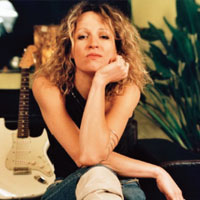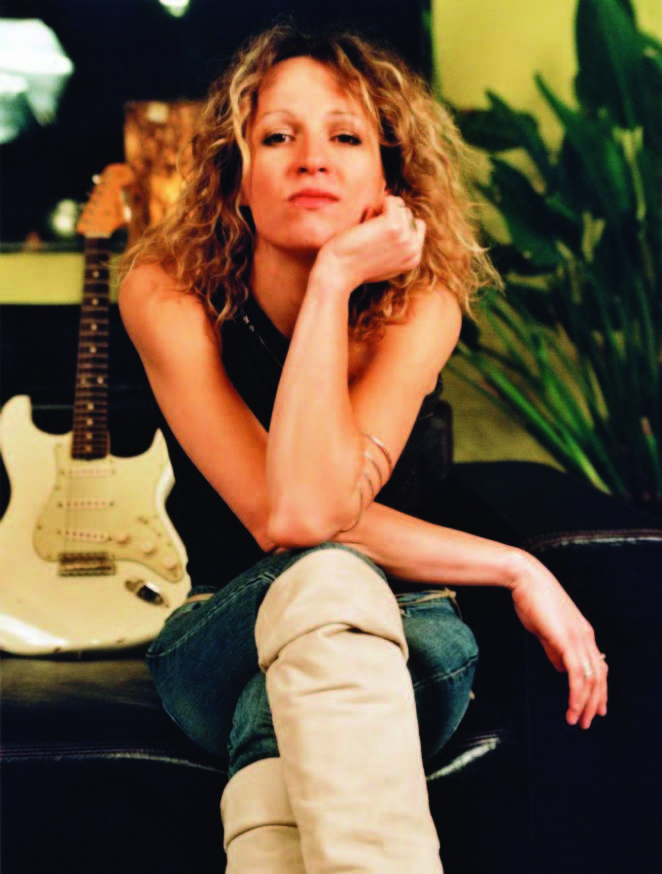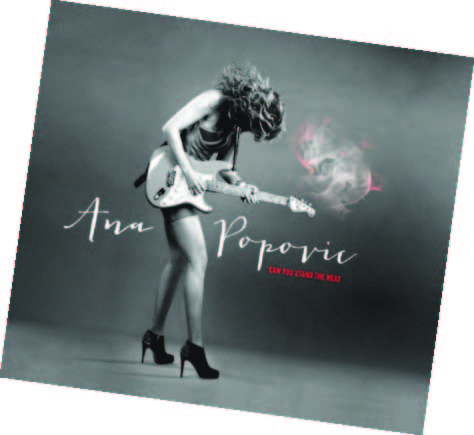Ana Popovic
Serbian-born Ana Popovic has been slowly building a reputation as a blues/rock guitar powerhouse. It’s taken a period of years for her to break out, and she’s withstood occasional sexist attitudes of male musicians, but with determination and hard work, not to mention a series of quality recordings and stunning live shows, this Strat-wielding lady has steadily garnered more fans and continues to do so.
Born in May 1976, Popovic is the daughter of working class parents. Her father is an active guitarist and bassist. American roots music was a constant around the Popovic household and Ana gravitated to the instrument at age fifteen, and began studying guitar with a teacher. An outstanding student, Popovic almost pursued a career in graphic design, but the lure of the blues was undeniable. In the ‘90’s, she finally dedicated herself to music and hasn’t looked back.
Growing up in Serbia, Ana was exposed to a lot of music, and with her father’s influence, she was drawn to the guitar.
“I would watch my father and his friends gather together and just end every night with a jam. I loved the part about jamming. Whoever could play a couple of notes could sit in. Some of them played great, and I thought, ‘If I could play a song or two, I would love to be a part of this.’ That’s how I started. I always loved the guitar. I have listened to blues players ever since I was two or three years old, everything from Delta blues, Texas blues, rock. It was always American music at home. When I was six or seven, I could tell Stevie Ray from Buddy Guy, and I loved hearing Albert King, Albert Collins, Jimmy Reed, B.B. King, Eric Clapton, Duane Allman, Jimi Hendrix and Elmore James.”
Ana learned her first riffs from her father, but studied formally.
“I also started learning from records. I picked up lots of slide from Elmore James, and my first solo came from Albert King. Later on, when I was seventeen, I started taking lessons-sort of group rock guitar lessons in downtown Belgrade, and finally, when I moved to Holland, I studied jazz at Utrecht and Rotterdam conservatories.
“I think learning guitar is whatever works for you. There are no rules, depending on your time schedule during the day, or your school or touring. Online courses are great if you’re on the road a lot, but it comes down to whatever inspires you to really take time and make a schedule, and planning on what you want to achieve in a certain time frame. I think a combination of formal study is best because it keeps it fresh. What I used to do back then was sit next to a record or cassette player for hours. I would get so inspired by what I was hearing that I couldn’t resist copying not only the licks, but the effortlessness of what those guys were playing.”
Ana did encounter some sexist attitudes from male musicians along the way.
“I never took that as an insult, although maybe some of their comments were meant to be insulting. I liked the fact that it was unusual and I always wanted to be different. Nowadays, there are so many girls with guitars, and that’s good. I just don’t respond to attitudes. I know that competition is huge in the guitar world, and the market is limited. Lots of people want to play, but can’t find their own way, or whatever makes them unique. Let me put it this way; you would never hear insulting comments from a good player who is satisfied with where his career is going.
“Blues players are much more encouraging to female musicians, but I think that will change in the rock world with time too. It’s about time they accept some ladies. The rock world needs strong guitar women are gonna’ step out an uncompromisingly demand respect, whatever their style is.”
Through tireless gigging and hard work, Ana has won over fans playing blues and rock worldwide, but we were curious if she has noticed a downturn in the blues’ popularity.
“There are definitely new markets out there. There are a lot of followers of American music in Asia. Eastern Europe is becoming a strong market as far as the organization of great events in music. I fell in love with American audiences, but kept building my European following at the same time, and we keep adding new territories every year; Dubai, Indonesia, India this year, plus Japan for the first time. It’s amazing to see the markets shift like that. It’s a shame to see blues clubs closing down, but a lot of blues bars in America stopped investing in sound systems, stages, etc. It’s fun to play a real juke joint. They should stay untouched, because they’re a part of the American heritage, but come on! Lots of bars would have very bad sounding rooms and thought they could get away with it. The new, younger audiences got tired of listening to the great players and not being able to hear or see them.”
Ana’s latest recording, Can You Stand The Heat, came about through her association with drummer/ producer Tony Coleman. She had a particular sound in mind upon entering the recording studio that partially stemmed from her recent move to Memphis, Tennessee.
“Tony and I had the same idea; blues has got to be groovy, even when you play a slow blues, you need to be moving your body to the beat. That’s what we miss on the blues scene nowadays; it’s not groovy. When you listen to Albert King and Albert Collins, they were so funky, even when playing a slow blues. So, we wanted a blues/funk record, something old school like War, Mandrill, James Brown, those types of ‘70’s jam/funk bands.
“Moving to Memphis has definitely had an effect on my music. Nobody plays like the Memphis guys. You could walk into a juke joint there and it’s like you walked into a movie fifty years ago, prime time for soul and funk. It’s very inspirational. If you move away from Beale Street, you can find great, barely known bands that just rip it up!”
As a wife and the mother of two small children, we were inquisitive as to how Ana balances her career and family. How challenging is it, and how does she make it work?
“It’s hard at times, and takes a lot of organization and dedication from my husband and our families. We plan tours in a way that’s ‘doable’ for the kids. The family comes first. We say ‘No’ a lot, and still have a full agenda. When the kids are with me on tour, I visit children’s museums, playgrounds and movies, and our booking agencies know when we require shorter drives, days off and different types of accommodations.”
Ana is a dyed-in-the-wool Stratocaster player, and explains why.
“The Strat has always been my guitar. I tried so many guitars and always kept coming back to Strats. I can express myself through those guitars the best. I love the tone, the neck, the tension, and they make you work! It’s not particularly easy to get the right tone on a Strat. I have played other guitars that play and sound ‘right.’ Those guitars make you lazy. The Strat makes you work for every note. When I got my ’64 Strat, I needed time to ‘tame’ that guitar. It was a wild guitar; much different than the custom ship models. The ’64 responds to everything you do on its neck. Besides that guitar, I also have a Fiesta Red reissue ’57 Strat that I’ve had for fifteen years, and I also have a ’60 Custom Shop model.
“I use DR Strings, the ‘Pure Blues’ set starting at .011 gauge. I play through a Mesa Boogie Mark 4 amp that I’ve been using a long time now. For effects, I have an original Ibanez Tube Screamer, a Vox wah with the British flag, and an original Boss Chorus, the light blue one with two knobs. For acoustics, I have an Ovation 12-string and a Martin D-28. I recently started helping Fame Guitars, European handmade instruments. They’re for players who love handmade guitars but can’t afford the real deal. Fame guitars are handmade and affordable.”
What’s on the horizon for Ana Popovic?
“We’ll keep on promoting our new record with my four piece band and nine piece all-star band, Ana Popovic & The Mo’ Better Love Band. We plan on going into the studio in between tours to put a couple of songs on tape. There’s a constant stream of ideas when you plays with these cats. Somewhere along the line, there should be a live record and DVD.”
Finally, Ana sees her success as helping to open the door for more female guitarists.
“I would love to do that. I was never too busy with other people’s prejudices. I had a clear picture of where I wanted to go with my music, and was busy fulfilling that dream.”
By Bob Cianci






